10 Things To Know About Perennials
Perennial plants are the backbone of many flower gardens. Unlike annual plants, which must be replanted each spring, herbaceous perennials die to the ground at the end of the season, and then re-grow from the same roots the following year. People grow perennial flowers because many of them are such easy-care, dependable performers, and because they offer an enormous variety of color, texture and form.
Here are 10 tips to remember about Perennials
1. Herbaceous perennials lack a persistent stem; they die back to the ground during winter and re-grow from the roots the next year so don't panic if you don't see stems in early spring!

2. Most perennials should be divided when they are dormant. (Spring bloomers in the fall: fall bloomers in the spring)
3. Many perennials spread by sending out shoots from their roots which develop into new stems, great for filling in a bed or sharing with friends.
4. Some perennials, such as columbines and delphiniums, are short-lived, lasting only three or four years but some will reproduce themselves from seed.
5. An upside to perennial plantings is the amazing varieties of color, texture and sizes available.
6. A downside is that perennials do require some maintenance even though you do not have to replant each year. Some varieties are aggressive and must be thinned so they do not take over the entire flower bed.
7. Generally speaking, perennial flowers start off small in the first year then with each growing season, produces bigger and more abundant blooms. Once they get to be about three years old, you might have to think about dividing them to keep them healthy and looking their best.
8. A key to designing with perennials is making sure there is continuing blooms and interest which means more careful garden planning than when using annuals.
9. With so many to choose from, books on perennials are an invaluable resource. They provide photographs for identification (and inspiration!), cultural information, a description of growth habits, bloom time, color and characteristics of special cultivars. Universities and garden centers may have handouts that will help to guide you.
10. Even though most retailers are diligent and aware, still beware of invasive perennial plants. The best advice is to check with your state's Department of Natural Resources to learn which plants Ohio has deemed invasive.
30 years of Growing
Meadow View Growers
New Carlisle, OH
www.meadowview.com